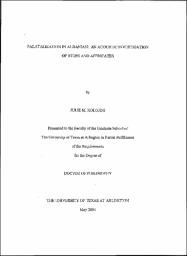| dc.description.abstract | Palatalization is a very common process cross-linguistically; it has been widely attested in both Indo-European (e.g. Slavic) and non-Indo-European languages (e.g. Bantu and Chinese). Palatalization can be broken down into velar palatalization (e.g. k, g > t∫, dy/_ i, j) and coronal palatalization (e.g. t, d > t∫, dy/__ j), whereby the targets tend to be velar and alveolar stops and the triggers are frequently non-back vowels and glides. The outputs of palatalization are often sounds formed in a different place of articulation than the original target segment and with a different manner of articulation than the target, which frequently results in a palato-alveolar affricate. Palatalization in Albanian, however, was ignited not only by velar and alveolar stops before non-back vocoids, but also by spirant and glide strengthening in the word-initial position. In Albanian, the output of palatalization was the voiceless and voiced palatal stop (e.g. k, g > c, f/_ i, j; t, d > c, f /__j s, j > c, f/#_, respectively). More recently, for many native speakers (NSs) of Albanian, the palatal stops have changed into palato-alveolar affricates, e.g. c, f > t∫, dy. That is, the complex palatal stops have gone from being coronal-dorsal to coronal; this de-dorsalization of palatal stops is especially the case in the Gheg variety of Albanian, and is beginning to be the case in the Tosk variety, as well. In the case that the Albanian palatal stops are becoming palato-alveolar affricates, this change could constitute the final stages in the palatalization process of velar, coronal, and palatal sounds. Further, this final stage of palatalization represents a merger of phonemic Albanian palatal stops with phonemic Albanian palato-alveolar affricates, whereby the contrast between the two distinct phonemes is lost; as a result of the merger, the marked former is lost in favor of the less marked latter. These claims are verified using the speech of 100 NSs of Albanian (50 Gheg and 50 Tosk), whereby both temporal and spectral characteristics of the target phonemic voiceless and voiced palatal stops and palato-alveolar affricates of the Albanian language have been measured. | en_US |


